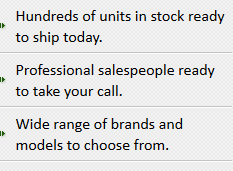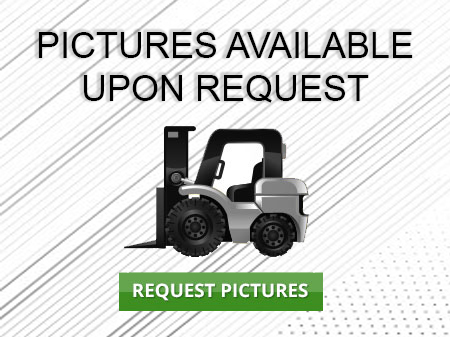Rough Terrain Forklift Gresham
Used Rough Terrain Forklift Gresham - Forklifts rely on two forks to unload, load and transport items. Forklifts fall into two main categories, industrial forklifts and rough terrain forklifts.
Industrial forklifts are mainly used in loading docks and warehouse applications with smooth and level surfaces. By contrast, the second category of forklifts, rough terrain forklifts, are commonly used to run on uneven and rocky surfaces. Commonly found at exterior construction sites, rough terrain forklifts have the tires, size and weight capacity to handle heavy loads. The main difference between rough terrain and industrial forklifts is the cushion tires that are on industrial forklift models. Rough terrain models rely on pneumatic tires, a kind of tractor tire known for better floatation and traction abilities. Internal combustion engines can power industrial forklifts; however, more often they rely on an electrical source such as a fuel cell or better. Rough terrain models typically rely on an internal combustion engine.
Types of Class 7 Rough Terrain Forklift Trucks
The three types of Class 7 Rough Terrain Forklift Trucks include the rotating telehandler forklifts, telehandler forklifts and straight mast forklifts.
Every rough terrain forklift truck is designed to operate on disturbed ground and difficult locations commonly found in military and construction atmospheres. A rough terrain forklift also offers increased maneuverability and performance. In the case of rough terrain forklift operations, extra consideration must be given while raising loads in these rough, variable conditions to prevent tip-over. As with all forklift operation, the machine must be in a position to remain stable before lifting, transporting or lowering a load. Stability of ground and knowledge of proper lifting technique is essential for safe operation of rough terrain forklifts.
Straight Mast Forklifts
Straight mast forklifts are designed to transport building materials around a range of rough terrain sites such as demolition and construction sites. Better accessibility and maneuverability are offered by these units thanks to their pneumatic cushion tires. Uneven ground and rough surfaces are no match for pneumatic tires. Most straight mast forklift units have 2WD or 4WD configurations. The majority of straight mast forklifts rely on propane or diesel fuel to equip them for interior short-term jobs. However, these machines are best suited for outside jobs. Straight mast forklifts have a similar lift capacity compared to standard forklift models; ranging from 5K to 36K lbs.
Telehandler or Telescopic Handler Forklifts
Telehandler or telescopic handler forklift trucks are equipped with a telescoping boom, giving them their name. Telescoping booms are handy for allowing the machine to load and place items at different lift heights and distances in front of the forklift. The reachability of the forklift provides the operator with greater flexibility when placing a load.
A standard telehandler forklift is long and low, with two wheels at the very front of the forklift and another pair of wheels toward the rear of the machine. The telescopic boom can be found at the back of the forklift, mounted on a pivot that is attached many feet higher than the frame of the unit. The hydraulic fluid tank and fuel tank are mounted on the opposite side of the cab which is usually situated on the left side of the forklift. The forklift engine and transmission are situated along the center of the machine. Creating a balanced machine is essential for a well-designed forklift. Having this particular configuration generates a stable environment for lifting, lowering and transporting loads.
Telehandler units offer significantly higher lifting heights compared to standard units. Otherwise known as high-reach telehandlers or compact telehandlers, these models perform. Compact telehandlers can extend their full load capacity from eight-teen feet and the high-reach models to fifty-six feet. Their load capacities usually range between 5,500 and 12,000 pounds.
All-terrain forklifts rely on all-wheel steering to deliver better maneuverability and stability. Thanks to steering features including power-shift transmission, the operator can maneuver the machine in excellent proximity to the work location.
The latest telehandler models feature ergonomic upgrades for ultimate operator comfort. These features include tilted steering options and roomier cabs to increase operator comfort. These ergonomic upgrades have been shown to lessen repetitive stress injuries and lessen operator fatigue.
A single joystick is a common design for most telehandlers. The joystick is responsible for the hydraulic system and the boom operations.
Telehandler forklifts can also be equipped with non-marking tires which allow them to be used in other applications such as the installation of signs and billboards as well as maintenance on buildings and stadiums.
Rotating Telehandler or Roto Telescopic Handler Forklifts
Roto telescopic handler forklifts or rotating telehandlers have numerous items in common with the standard telehandler model. The rotating telehandler can lift excessive loads to extreme heights safely and efficiently. The turntable or rotating ability add extra panache. Not having to reposition the forklift saves time and money. The rotating models have access to 360 degrees, creating a much greater workspace with immediate access.
With rotating telehandlers, one joystick handles the lift capacity and a second joystick is responsible for the rotation factor. Useful additional features may be added to your standard telehandler or rotating telehandler including 4WD, increased traction via minimized slip differential on the rear axle, and power-assist steering.
Of course, a machine that can rotate has extra safety considerations to understand. Because of this, rotating telehandler rough terrain forklifts come with stabilizers to increase the safety when rotating loads from one side of the forklift to the other. Some rotating telehandlers do not have stabilizers. These units are created to move and work in various aspects of the job site and are easier to reposition without stabilizers.
Rotator telehandler units are typically smaller than standard telehandlers with their fixed-cab design. Because of this, their load capacities are also smaller than the standard telehandler. Rotating telehandlers offer load capacities ranging from 4000 to 10,000 lbs. and lift heights between fifteen to eighty feet.
Standard and rotator telehandlers can double as a crane when outfitted with specific winch accessories. This means that these forklifts can sometimes allow a project to forego the need for a crane at the jobsite, saving time, expense and workspace.
Advancements for Rough Terrain Forklifts
Many attachments are currently available for rough terrain forklifts, such as booms, winches, rotating fork carriages and articulating booms. More rough terrain forklift attachments will be unleashed onto the market in future years thanks to their ability to make the forklift more multi-purpose than ever before.
However, the bulk of advancements are expected to be in the form of safety features, built-in to manufactured rough terrain forklifts. The latest safety upgrades include automatic load restriction and other features. This system weighs a load automatically and then calculates the safe reach distance of the load while considering the extension and boom angle. An alarm will go off once the safe distance is reached. This alerts the operator that immediate adjustments need to be made to the boom angle, reach distance or load weight.
Rough Terrain Forklift PDF
Stock Number: 209058 GL
Make: LIFTKING
Model: LK12M42
Year: 2015
| Stock Number |
209058 GL |
| Make |
LIFTKING |
| Model |
LK12M42 |
| Year |
2015 |
| Category |
Rough Terrain Forklift |
Stock Number: 267846 GL
Make: Liftking
Model: LK12000
Year: 2003
| Stock Number |
267846 GL |
| Make |
Liftking |
| Model |
LK12000 |
| Year |
2003 |
| Category |
Rough Terrain Forklift |
Stock Number: DP-MAN008 GL
Make: MANITOU
Model: MH25-4T
Year: 2016
| Stock Number |
DP-MAN008 GL |
| Make |
MANITOU |
| Model |
MH25-4T |
| Year |
2016 |
| Category |
Rough Terrain Forklift |
Stock Number: 208325 GL
Make: MANITOU
Model: M50.4
Year: 2015
| Stock Number |
208325 GL |
| Make |
MANITOU |
| Model |
M50.4 |
| Year |
2015 |
| Category |
Rough Terrain Forklift |
Stock Number: LS15257 GL
Make: JCB
Model: 930
Year: 2013
| Stock Number |
LS15257 GL |
| Make |
JCB |
| Model |
930 |
| Year |
2013 |
| Category |
Rough Terrain Forklift |
Stock Number: EQC008213 GL
Make: MANITOU
Model: M50
Year: 2017
| Stock Number |
EQC008213 GL |
| Make |
MANITOU |
| Model |
M50 |
| Year |
2017 |
| Category |
Rough Terrain Forklift |



























